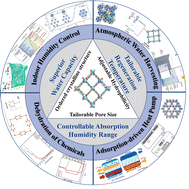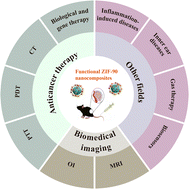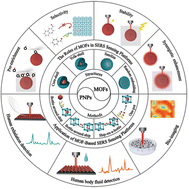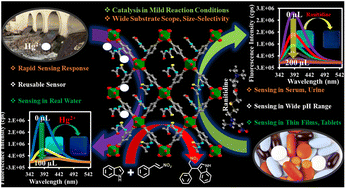Themed collection FOCUS: Design and applications of metal-organic frameworks (MOFs)

Surface functionalization of metal–organic framework nanoparticle for overcoming biological barrier in cancer therapy
Surface modification of MOF particle for overcoming biological barriers.

Inorg. Chem. Front., 2024,11, 3119-3135
https://doi.org/10.1039/D4QI00523F
Advancing biomedical applications of polyoxometalate-based metal–organic frameworks: from design to therapeutic potential
The review covers POMOF materials synthesis, modification, and unique properties, focusing on biomedical sensors and therapies. Finally, the review summarises the challenges and developments of POMOFs in biomedicine.

Inorg. Chem. Front., 2024,11, 1339-1365
https://doi.org/10.1039/D3QI02414H
Recent advances in metal–organic frameworks for water absorption and their applications
Metal–organic frameworks (MOFs) are promising water adsorbents with a controllable absorption humidity range, superior water capacity, and tailorable regeneration conditions.

Mater. Chem. Front., 2024,8, 1171-1194
https://doi.org/10.1039/D3QM00484H
Research advances and applications of ZIF-90 metal–organic framework nanoparticles in the biomedical field
A schematic illustration of ZIF-90 nanocomposites applied to anticancer therapy, biomedical imaging and other fields for the treatment of different diseases.

Mater. Chem. Front., 2024,8, 1195-1211
https://doi.org/10.1039/D3QM01020A
Metal–organic frameworks for electrocatalytic hydrogen peroxide production
This review summarizes the recent advances in the design of MOF-based 2e-ORR electrocatalysts for H2O2 production with the current challenges and future perspectives discussed, aiming to inspire the further development of this emerging field.

Mater. Chem. Front., 2024,8, 1084-1100
https://doi.org/10.1039/D3QM00972F
Application of MOF-derived materials as electrocatalysts for CO2 conversion
This review summarizes the four main synthesis strategies of MOF-derived materials, and the feasibility and challenges of MOF-derived materials in ECO2RR are discussed.

Mater. Chem. Front., 2023,7, 6107-6129
https://doi.org/10.1039/D3QM00835E
Current progress in metal–organic frameworks and their derivatives for electrocatalytic water splitting
For electrocatalytic water splitting, MOFs can be optimized through structural modification, plane design and synergetic composite systems, and the annealing process further expands the types of MOF-based electrocatalytic materials.

Inorg. Chem. Front., 2023,10, 6489-6505
https://doi.org/10.1039/D3QI01468A
Recent progress in metal–organic frameworks for the separation of gaseous hydrocarbons
This review highlights recent research progress in MOF materials for the important separation of gaseous hydrocarbons, especially for ethylene, propylene, and butadiene. The uniqueness of MOFs to achieve those progress is also outlined.

Mater. Chem. Front., 2023,7, 5693-5730
https://doi.org/10.1039/D3QM00430A
Macroscopic alignment of metal–organic framework crystals in specific crystallographic orientations
This review explores synthetic strategies for macroscopic aligned MOFs, enhancing properties without structural designs or post-synthetic reactions.

Mater. Chem. Front., 2023,7, 5545-5560
https://doi.org/10.1039/D3QM00678F
MOFs meet membrane: application in water treatment and separation
Metal–organic frameworks (MOFs) are solid crystalline materials formed by the self-assembly of organic ligands and metal ions or clusters. Combining the advantages of membrane separation and MOFs, MOFs-based membranes are used in water treatment.

Mater. Chem. Front., 2023,7, 5140-5170
https://doi.org/10.1039/D3QM00487B
Metal–organic framework-based SERS sensing platforms for life and health detection
Schematic diagram of MOF-based SERS sensing platforms for life and health detection.

Mater. Chem. Front., 2023,7, 4880-4899
https://doi.org/10.1039/D3QM00471F
Recent advances in the synthesis and catalytic applications of metal–organic framework/covalent organic framework composites
MOF/COF composites constructed by heterojunction, functionalization, or integration show enhanced performance in photo-, thermo-, and electrocatalysis. This review is informative for rational design and mechanism understanding of MOF/COF catalysts.

Mater. Chem. Front., 2023,7, 4782-4809
https://doi.org/10.1039/D3QM00565H
Porous framework materials for stable Zn anodes in aqueous zinc-ion batteries
This review summarizes the recent research efforts on MOFs/COFs employed in Zn anodes of zinc-ion batteries (ZIBs) and analyzes the structure-property relationship to guide the rational design of MOFs/COFs for future ZIB applications.

Inorg. Chem. Front., 2023,10, 5555-5572
https://doi.org/10.1039/D3QI01222K
Recent developments in transition metal-based MOFs for electrocatalytic water splitting emphasizing fundamental and structural aspects
In this review, recent advancement of MOF based materials and their role towards OER is explored. Tuning of structures by adopting various synthetic strategical techniques are discussed for the first time.

Mater. Chem. Front., 2023,7, 2120-2152
https://doi.org/10.1039/D3QM00089C
Rare earth-based MOFs for photo/electrocatalysis
This review provides current research progress on rare earth MOFs, including synthesis methods and photocatalytic and electrocatalytic applications of rare earth MOFs.

Mater. Chem. Front., 2023,7, 806-827
https://doi.org/10.1039/D2QM01201D
Recent advances in metal–organic framework based heterogeneous catalysts for furfural hydrogenation reactions
This review summarizes the recent advances in upgrading FFR to high value-added chemicals using MOF-based heterogeneous catalysts.

Mater. Chem. Front., 2023,7, 628-642
https://doi.org/10.1039/D2QM01181F
Construction of excellent solid-state electrolyte by incorporating Li-IL into open-pore MOF/polymer-based materials
We obtained MOF–polymer distinguished from conventional pore clogging by coaxial electrospinning. After activation, Li-IL was ligand-loaded with MOF to obtain a CSE with a high efficiency combination of the three systems and excellent performance.

Mater. Chem. Front., 2024,8, 3166-3174
https://doi.org/10.1039/D4QM00436A
Tuning the organic ligands to optimize the nitrogen reduction performance of Co(II) or Ni(II)-based MOFs
The electrocatalytic nitrogen reduction to NH3 performance of five Co(Ni)-MOFs with a similar structure can be optimized significantly by adjusting the functional block of the pyridine-bridging ligands.

Mater. Chem. Front., 2024,8, 3203-3213
https://doi.org/10.1039/D4QM00418C
Visible-light-active benzothiadiazole-based MOFs as efficient ROS generators for the synthesis of benzimidazoles and benzothiazoles
We provided a convenient approach to integrate the 2,1,3-benzothiadiazole-based organic linker into a UiO-68-type MOF as the first example generating O2˙− and 1O2 for the green synthesis of benzimidazoles and benzothiazoles.

Inorg. Chem. Front., 2024,11, 5973-5978
https://doi.org/10.1039/D4QI01368A
Universal synthesis of coral-like ternary MOF-derived sulfides as efficient OER electrocatalysts
Synthesize and tune a series of trimetallic sulfides to achieve efficient catalysis for the OER.

Inorg. Chem. Front., 2024,11, 6064-6071
https://doi.org/10.1039/D4QI01725K
Exposing coordination-unsaturated Co sites in Co-MOF for efficient photocatalytic water oxidation
Two metal–organic framework catalysts with different cobalt coordination environments demonstrate the importance of coordinated-unsaturated metal sites for photocatalytic water oxidation.

Inorg. Chem. Front., 2024,11, 5484-5489
https://doi.org/10.1039/D4QI00968A
Superhydrophobic fluorinated metal–organic framework (MOF) devices for high-efficiency oil–water separation
A series of fluorinated UiO-66 was prepared using the bottom-up method. The composites of 2CF3-UiO-66 and cotton show excellent oil–water separation efficiency (up to 99.66%).

Inorg. Chem. Front., 2024,11, 5636-5647
https://doi.org/10.1039/D4QI01613K
2D pyrene-based metal–organic framework nanobelts as efficient photocatalysts for the coupling of thiols into disulfides
2D pyrene-based metal–organic framework nanobelts for the photocatalytic coupling of thiols into disulfides.

Inorg. Chem. Front., 2024,11, 5700-5708
https://doi.org/10.1039/D4QI01273A
Regulating photocatalysis by external-stimuli manipulation of the microenvironment in europium–organic frameworks
Eu-MOF-T can transform into Eu-MOF-S under solvents. Eu-MOF-S can convert into Eu-MOF-T upon temperature. Eu-MOF-S demonstrates a superior photocatalytic CO2RR capacity of 7886.1 μmol g−1 h−1, Eu-MOF-T is only 599.7 μmol g−1 h−1.

Inorg. Chem. Front., 2024,11, 5685-5691
https://doi.org/10.1039/D4QI01226G
Bimetal-doped cobalt oxyhydroxides/hydroxides synthesized by electrochemistry for enhanced OER activity
Metal hydroxides and oxyhydroxides are efficient catalysts for electrochemical oxygen evolution reactions.

Inorg. Chem. Front., 2024,11, 5449-5457
https://doi.org/10.1039/D4QI00823E
Electronic metal–support interaction via Ni defect-induced Ru-modified Ni–CeO2 for enhanced hydrogen oxidation activity
A defect-rich Ru/Ni–CeO2 catalyst was fabricated using a MOF-mediated pyrolysis-reduction strategy. The robust EMSI effect between Ru and Ni–CeO2 with abundant Ni defects provides striking HOR activity and resistance to CO poisoning.

Inorg. Chem. Front., 2024,11, 5244-5253
https://doi.org/10.1039/D4QI01233J
Zirconium-based metal–organic frameworks: the relation between linker connectivity, structure stability, and catalytic activity towards organophosphates
The stability of MOFs in aqueous environments is influenced by the linker topicity rather than by the connectivity. Only MIP-200 survives the alkaline environment.

Inorg. Chem. Front., 2024,11, 5319-5335
https://doi.org/10.1039/D4QI01366B
A D–A–D-type di-lophine derivative-based photoactive metal–organic framework: fluorescence sensing of UO22+ and photochromic behavior
A cadmium-based photoactive MOF was designed to achieve fluorescence sensing to various hazardous analytes, especially UO22+, and to exhibit photochromic behavior in response to light exposure.

Inorg. Chem. Front., 2024,11, 5127-5136
https://doi.org/10.1039/D4QI01105H
Bimetallic ZnCo-MOF derived porous Ir-doped cobalt oxides for water oxidation with improved activity and stability
This study proposes a precise base-etching process to prepare MOF-derived Ir-doped ZnCo oxides as electrocatalysts with advantages of improved porous nanostructures and in situ formed oxygen vacancies.

Inorg. Chem. Front., 2024,11, 4876-4885
https://doi.org/10.1039/D4QI01022A
Single-component rare-earth-free white light-emitting metal–organic framework towards nitroaromatic explosive sensing and dye adsorption
Cd-PNMI, a white-light-emitting MOF, demonstrates ratiometric fluorescence quenching of nitro explosives and toxic substances, and possesses the capability to rapidly and selectively adsorb Rhodamine B and fluorescein dyes from waste liquids.

Inorg. Chem. Front., 2024,11, 4826-4834
https://doi.org/10.1039/D4QI00747F
GSH/pH dual-activated POM@MOF for tumor cell-specific synergistic photothermal and chemodynamic therapy
A tumor microenvironment-specifically activated POM@MOF was developed for PTT/CDT combination therapy against tumor cells.

Inorg. Chem. Front., 2024,11, 4439-4448
https://doi.org/10.1039/D4QI01079E
Fabrication of a Cu(I)-carboxylate metal–organic framework by reduction of metal nodes for an azide–alkyne “click” reaction
A stable Cu(I)-carboxylate MOF is fabricated by ascorbic acid reduction, which breaks HSAB theory and achieves in situ phase transitions. The resultant Cu2H2DOBDC acting as a CuAAC catalyst exhibited superior catalytic performance.

Inorg. Chem. Front., 2024,11, 4263-4269
https://doi.org/10.1039/D4QI00922C
The potential of an MOF accelerator in an electrochemiluminescence system for sensitive detection of menthol enantiomers
The critical element of an electrochemiluminescence (ECL) chiral sensor is the chiral electrode modifier.

Inorg. Chem. Front., 2024,11, 4241-4248
https://doi.org/10.1039/D4QI00641K
A sunlight sensitive metal–organic framework film for the environment-friendly self-sterilization application
This work provides a sunlight sensitive MOF film with the unique advantage of easy and superfast preparation, and environmentally-friendly self-sterilization, offering a potential approach for the long-term usage of disposable protective equipment.

Inorg. Chem. Front., 2024,11, 4229-4240
https://doi.org/10.1039/D4QI00715H
Construction of a novel nickel-based MOF with accessible oxygen sites for efficient CH4/N2 separation
A novel Ni-based MOF material, TUTJ-201Ni, with accessible oxygen sites, was constructed. The material displayed ultrahigh thermal stability, showing a high separation performance for CH4/N2 mixture.

Inorg. Chem. Front., 2024,11, 3889-3896
https://doi.org/10.1039/D4QI01008F
Enhancing enantioselectivity in chiral metal organic framework fluorescent sensors
Zn(II) chiral MOFs with BINOL and D-camphoric acid exhibit exceptional enantioselectivity as chiral fluorescence sensors.

Inorg. Chem. Front., 2024,11, 3877-3888
https://doi.org/10.1039/D4QI00760C
Anti-Kasha's rule in phenothiazine derivatives and metal–organic frameworks: mechanism investigation and application in hypochlorite detection
Two phenothiazine derivatives and a Cd-MOF (Cd-PTZ-db) were synthesised and investigated for their anti-Kasha’s rule emissions in solid state. Cd-PTZ-db can be further applied for the detection of ClO− (hypochlorite).

Inorg. Chem. Front., 2024,11, 3984-3991
https://doi.org/10.1039/D4QI00838C
A highly sensitive Zr-MOF mediated multi-enzyme cascade platform for the colorimetric and fluorescent dual-signal determination of sarcosine
Herein, a highly sensitive detection platform for the dual-mode determination of sarcosine by fluorescence and colorimetry was constructed based on zirconium-based metal organic frameworks (Zr-MOFs) with multi-enzyme immobilization.

Inorg. Chem. Front., 2024,11, 3820-3829
https://doi.org/10.1039/D4QI00841C
An unprecedented Cu6 cluster-based bimetallic MOF with multiple open sites for high CO2 capture and efficient CO2 conversion
Through soft-hard acid-base theory, a novel bimetallic MOF (JLU-MOF108) with an unprecedented 12-connected Cu6 cluster SBU was synthesized. LAS and LBS inside JLU-MOF108 exhibited significant CO2 capture and conversion capability.

Inorg. Chem. Front., 2024,11, 3494-3502
https://doi.org/10.1039/D4QI00692E
High ratios of Ni3+ and Co3+ facilitated by Mn-addition for enhanced oxygen evolution reaction and ethanol oxidation reaction
The design of dual-functional catalyst for oxygen evolution reaction and ethanol oxidation reaction is essential for improving H2 production efficiency, and one strategy to improve catalytic performance is the incorporation of high-valence metal.

Inorg. Chem. Front., 2024,11, 3446-3457
https://doi.org/10.1039/D4QI00629A
Magnifying the turn-on luminescence and electrical conductivity via the coupling effect of oxidation, metal ion adhesion and pressure within MnII-MOFs
Magnifying the turn-on luminescence and electrical resistivity of MnII2-MOFs through the coupled effect of oxidation, metal ion adhesion, and pressure.

Inorg. Chem. Front., 2024,11, 3418-3425
https://doi.org/10.1039/D4QI00552J
A bimetallic CoZn metal–organic-framework derived CoZnS@NSC Co-catalyst loaded on g-C3N4 for significantly augmented photocatalytic H2 evolution
CoZnS@NSC nanoparticles derived from a CoZn-MOF were synthesized by an annealing–sulfurization strategy and used as co-catalysts for g-C3N4, which effectively augmented the photocatalytic H2 production.

Inorg. Chem. Front., 2024,11, 3435-3445
https://doi.org/10.1039/D4QI00644E
Local protons enhance photocatalytic CO2 reduction by porphyrinic zirconium-organic frameworks
MOF-OH with a large number of local proton sources not only modifies the microenvironment but also enables efficient charge separation, which thus exhibited effective CO2 capture and CO2 reduction under visible-light irradiation.

Mater. Chem. Front., 2024,8, 2439-2446
https://doi.org/10.1039/D4QM00187G
Electronic modulation by interfacial bridging between Ir nanoparticle and metal–organic framework to enhance hydrogen evolution
In the quest for amplifying the inherent capabilities of noble metals, crafting precise metal–support interfacial bonds stands as a challenging yet fruitful endeavor.

Inorg. Chem. Front., 2024,11, 3377-3386
https://doi.org/10.1039/D4QI00515E
Radiochromic semiconductive MOFs with high sensitivity and fast photochromic responses for dual-mode X-ray direct detection
A radiochromic semiconductor detector for dual-mode direct X-ray detection, showing rapid color changes and high sensitivity upon X-ray exposure, is reported. This allows quickly capturing object information through visual inspection and serves as an alternative means of direct X-ray detection.

Inorg. Chem. Front., 2024,11, 3316-3322
https://doi.org/10.1039/D4QI00771A
Vegard's law in multivariate libraries of porous interpenetrated zirconia organic frameworks
In this contribution we demonstrate that metal–organic frameworks (MOFs) with suitable underlying topological structure are amenable for the preparation of MOF-based substitutional solid-solutions (SSS) that follow Vegard's law.

Inorg. Chem. Front., 2024,11, 3021-3027
https://doi.org/10.1039/D4QI00354C
A chelating coordination modulation method for the synthesis of Ti-MOF single crystals
A chelation coordination modulation (CCM) method has been developed for the synthesis of novel Ti-MOFs.

Inorg. Chem. Front., 2024,11, 2876-2883
https://doi.org/10.1039/D4QI00436A
Ultrathin 2D–2D NiFe LDH/MOF heterojunction nanosheets: an efficient oxygen evolution reaction catalyst for water oxidation
An ultrathin NiFe LDH/MOF catalyst is grown on carbon paper by an in situ self-dissociation–assembly strategy. Studies reveal that the strong electronic interaction between Fe and Ni species with rich active sites results in good OER and OWS performance.

Inorg. Chem. Front., 2024,11, 2489-2497
https://doi.org/10.1039/D4QI00090K
Enhanced nonlinear optical response and ultrafast carrier dynamics in amorphous Fe-doped ZIF-67
We synthesized and characterized the amorphous Fe-doped ZIF-67. The nonlinear optical properties were enhanced in Fe-doped ZIF-67, producing the diverse mode-locking pulses.

Mater. Chem. Front., 2024,8, 1971-1980
https://doi.org/10.1039/D3QM01314F
Combination of dimensional reduction and active site addition strategies for preparing unique {RE9}-cluster-based MOFs: efficient CO2 fixation and Knoevenagel condensation
A series of 2D {RE9}-cluster-based rare-earth MOFs were built by dimensional reduction and active site addition strategies. They exhibit excellent catalytic activity in CO2 fixation and Knoevenagel condensation under mild conditions.

Inorg. Chem. Front., 2024,11, 2071-2080
https://doi.org/10.1039/D3QI02527F
Multiple signal amplification strategy using porous materials and novel controlled release self-on mode for ultrasensitive immunoassay
The porous structure of the luminophore, catalyst and carrier, combined with multiple signal amplification and novel controlled release encapsulation strategies, achieving an efficient self-on ultrasensitive ECL immunoassay for PSA.

Inorg. Chem. Front., 2024,11, 1799-1807
https://doi.org/10.1039/D4QI00011K
Synthesis of lanthanide-based scintillator@MOF nanocomposites for X-ray-induced photodynamic therapy
Nanocomposites were proposed and fabricated to simultaneously generate singlet oxygen (1O2) through energy transfer from SNPs to Hf-TCPP and hydroxyl radicals (˙OH) by the introduction of high-Z elements under low-dose X-ray irradiation.

Inorg. Chem. Front., 2024,11, 1607-1615
https://doi.org/10.1039/D3QI02301J
Construction of S-scheme heterojunctions of a Ti-doped Ce-MOF and BiOCl for efficient photocatalytic selective oxidation of amines
Regulating the microenvironment of the S-scheme heterojunction interface to promote efficient photocatalytic aerobic organic reactions under mild conditions.

Inorg. Chem. Front., 2024,11, 1583-1595
https://doi.org/10.1039/D3QI02645K
A novel multi-carboxyl functionalized MOF platform for effective photodynamic therapy with hypoxia modulation based on prominent self-oxygen generation
We for the first time, using a multicarboxyl modification strategy, integrated high density Fe-based catalytic centers and the clinically available ICG molecule into the same stable MOFs and obtained a novel self-oxygen generation enhanced PDT platform.

Inorg. Chem. Front., 2024,11, 1186-1197
https://doi.org/10.1039/D3QI02416D
Introducing alkyl chains to realize the construction of superhydrophobic/superoleophilic MOFs and the transformation from three-dimensional to two-dimensional structure
The introduction of organic side chains not only regulates the wettability of MOFs but also changes their structure/pore environment. This strategy provides a straightforward method to prepare superhydrophobic MOFs capable of efficient and selective separation of oil and water.

Inorg. Chem. Front., 2024,11, 1123-1134
https://doi.org/10.1039/D3QI02250A
Imine-linked donor–acceptor metal–organic frameworks for an efficient photocatalytic oxidative coupling reaction
We report two imine-linked donor–acceptor (D–A) MOFs with Cu(I) cyclic trinuclear units (CTUs) via Schiff base condensations and their high photocatalytic activity for aerobic oxidation reaction of benzylamines.

Inorg. Chem. Front., 2024,11, 417-424
https://doi.org/10.1039/D3QI02118A
Eu3+-MOF fluorescence sensor based on a dual-ligand strategy for visualised detection of an anthrax biomarker 2,6-pyridine dicarboxylic acid
A dual-ligand ratiometric fluorescence sensor based on lanthanide–metal–organic frameworks was successfully synthesised for the sensitive and convenient detection of DPA.

Inorg. Chem. Front., 2024,11, 269-277
https://doi.org/10.1039/D3QI01852K
A recyclable MOF@polymer thin film composite for nanomolar on-site fluorometric detection of heavy metal ion and anti-histamine drug and efficient heterogeneous catalysis of Friedel–Crafts alkylation
A recyclable MOF@polymer thin film composite was utilized for fast nanomolar fluorometric sensing of Hg(II) and ranitidine in serum, urine, tablets and waste water, and heterogeneous catalysis of Friedel–Crafts alkylation.

Inorg. Chem. Front., 2024,11, 142-155
https://doi.org/10.1039/D3QI01890C
Multi-stimulus responsive properties of a Cd-MOF based on tetraphenylethylene
The three-dimensional MOF Cd-tcbpe undergoes ligand conformational compression under multi stimulus response conditions, resulting in sensitive and reversible fluorescence color changes. This multi stimulus response behavior could be widely applied.

Inorg. Chem. Front., 2023,10, 7351-7358
https://doi.org/10.1039/D3QI01954C
Soft seed-mediated dimensional control of metal–organic framework nanocrystals through oil-in-water microemulsions
We demonstrate an environment-friendly universal methodology to control MOF crystal dimensions from nanometres to micrometres only by introducing an oil-in-water microemulsion.

Inorg. Chem. Front., 2023,10, 7146-7154
https://doi.org/10.1039/D3QI01567J
Pore environment reinforced laser dye fluorescence in an adenine-containing metal–organic framework with pocket-like channels
Confinement laser dye into two novel adenine-containing metal-organic frameworks with the same components but different pore environments and topologies exhibited distinct adsorptive luminescence behaviours.

Inorg. Chem. Front., 2023,10, 6860-6868
https://doi.org/10.1039/D3QI01569F
Synergetic microstructure engineering by induced ZB/WZ twin boundaries and S vacancies in a Zn0.5Cd0.5S-based S-scheme photocatalyst for highly efficient photocatalytic hydrogen production
Development of structurally unique Zn0.5Cd0.5S (with twin structure and S vacancies) and a Zn0.5Cd0.5S-based metal–organic framework for photocatalytic applications.

Inorg. Chem. Front., 2023,10, 6683-6700
https://doi.org/10.1039/D3QI01187A
Fabrication of ultrathin two-dimensional MOF nanosheets with cage-like cavities showing excellent adsorption for lead(II)
An ultrathin 2D MOF nanosheet with cage-like cavities was constructed, which showed an outstanding Pb2+ uptake capacity of 738.65 mg g−1 as well as ultrahigh selectivity and anti-interference performance.

Inorg. Chem. Front., 2023,10, 6566-6577
https://doi.org/10.1039/D3QI01619F
A highly connected metal–organic framework with a specific nonpolar nanotrap for inverse ethane/ethylene separation
A highly connected Tb-MOF possessing a specific nanotrap enriched with nonpolar aromatic rings shows an excellent inverse adsorption of C2H6 over C2H4 for one-step C2H4 purification.

Inorg. Chem. Front., 2023,10, 6407-6413
https://doi.org/10.1039/D3QI01595E
Both layered trihydroxide hollow cubes and bismuth oxide derived from MOF templates for high-performance alkaline batteries
A full battery was assembled with the CoNiMn-LDH cathode and the Bi2O3 anode derived from MOF templates, and achieved significant long-term cycling stability.

Inorg. Chem. Front., 2023,10, 5969-5978
https://doi.org/10.1039/D3QI00962A
Porous yet densely packed metal–organic frameworks (MOFs) toward ultrastable oxygen evolution at practical current densities
We report the confined growth of nickel, iron-metal–organic framework electrodes characteristic of porous yet densely packed architectures, which shows excellent activities toward oxygen evolution at the practical levels of catalyst loadings.

Mater. Chem. Front., 2023,7, 5005-5014
https://doi.org/10.1039/D3QM00614J
Flexible strontium-based metal–organic framework scintillation screens for high-resolution X-ray imaging
Flexible strontium-based metal–organic framework scintillation screens with strong radioluminescence sensitivity and water resistance were applied for high-resolution X-ray imaging.

Inorg. Chem. Front., 2023,10, 5710-5718
https://doi.org/10.1039/D3QI01231J
Ligand-regulated photoinduced electron transfer within metal–organic frameworks for efficient photocatalysis
By judiciously controlling the twisted conjugation between ligands and coordinated carboxylates to inhibit intramolecular photoinduced electron transfer process, an acridone-based metal–organic framework was obtained for efficient photocatalysis.

Inorg. Chem. Front., 2023,10, 5439-5451
https://doi.org/10.1039/D3QI01120H
Oxygen vacancies confined in hierarchically porous CsPbBr3@Pb-MOF through in situ structural transformation for promoting photocatalytic CO2 reduction
Via in situ structural transformation, hydrophobic hierarchically porous CsPbBr3@Pb-MOF with oxygen vacancies is prepared for efficient photoreduction of CO2 in the gas–solid mode.

Inorg. Chem. Front., 2023,10, 5098-5110
https://doi.org/10.1039/D3QI00596H
Two-dimensional conductive metal–organic frameworks as efficient electrocatalysts for oxygen evolution and reduction reactions
RhO4-HTC and RhN2O2-HTC based on 2D conductive MOFs are screened out as potential OER and ORR bifunctional electrocatalysts by using DFT calculations.

Inorg. Chem. Front., 2023,10, 5044-5052
https://doi.org/10.1039/D3QI01112G
About this collection
Metal–organic frameworks (MOFs) are widely recognized for their cage-like structure, which positions them as promising candidates in various fields such as catalysis, sensing, luminescence, drug delivery and imaging, adsorption and separation, as well as gas and energy storage.
This focus collection highlights the exciting research on the design and applications of MOFs that recently appeared in Materials Chemistry Frontiers and Inorganic Chemistry Frontiers. Articles featured in our focus collections are handpicked by Editors. We hope you find them enjoyable to read.